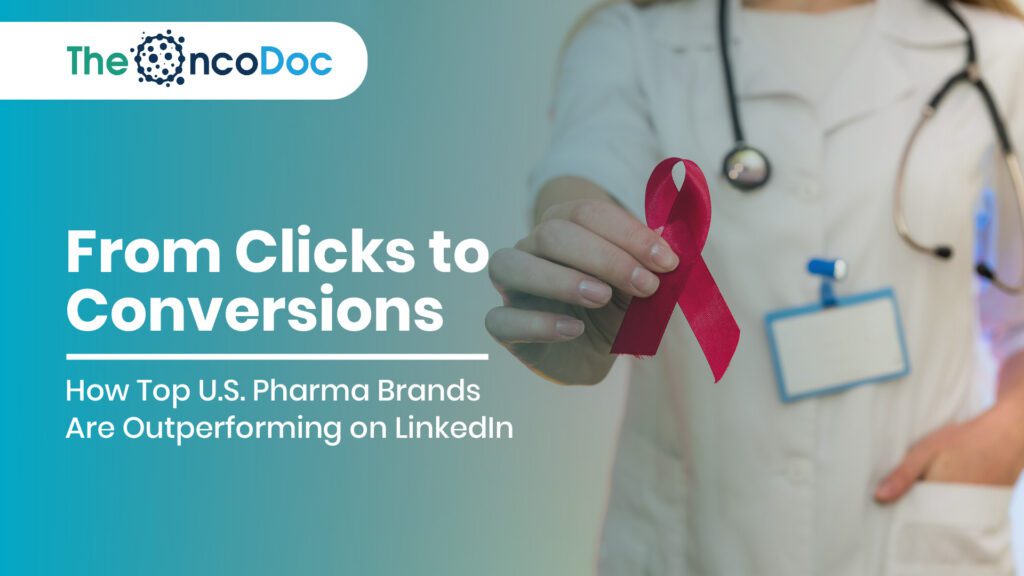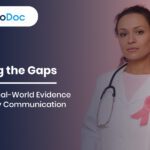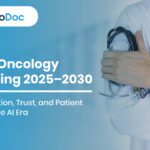Abstract
In the highly regulated and competitive landscape of oncology, a strategic digital presence is no longer optional—it is a critical driver of brand success. This article provides an in-depth analysis of how leading U.S. pharmaceutical brands are leveraging LinkedIn to transform clicks into meaningful conversions. We delve into the core tenets of a high-performance LinkedIn strategy, from audience-centric content creation and precision targeting to the sophisticated analytics required to measure true impact. With a focus on the unique challenges and opportunities within the oncology field, we provide a data-driven blueprint for pharma brand managers and medical professionals. The insights within this piece are designed to help you move beyond vanity metrics and build a digital footprint that educates, engages, and ultimately, drives business objectives, all while maintaining strict regulatory compliance.
Introduction: The New HCP Engagement Model
The traditional model of pharmaceutical marketing, heavily reliant on in-person sales calls and medical conferences, has been irrevocably altered by the digital revolution. Today’s healthcare professionals (HCPs) are digital natives, consuming information on their own terms and timelines. LinkedIn, with its powerful professional networking capabilities and a user base rich with physicians, researchers, and key opinion leaders (KOLs), has emerged as the premier platform for B2B pharma engagement. For oncology brands, where the stakes are highest and the need for timely, credible information is paramount, a well-executed LinkedIn strategy is a game-changer. It enables brands to bypass the noise of general consumer platforms and deliver hyper-relevant, scientific content directly to the people who need it most. This article will deconstruct the pillars of a successful LinkedIn strategy, examining the analytics that define success and the tactical execution required to outperform competitors.

The Strategic Imperative: Beyond the “Follow” Button
A common pitfall in digital marketing is confusing presence with purpose. Simply having a company page is not enough. Top-performing oncology brands treat their LinkedIn presence as a strategic asset with clearly defined objectives. The fundamental goal is to build a robust ecosystem of educational content that positions the brand not just as a product provider, but as a thought leader and a valuable partner in patient care.
Audience Segmentation and Targeting: The first step to a high-impact strategy is identifying and segmenting your audience. LinkedIn’s targeting capabilities allow for incredible precision, enabling brands to reach:
- Oncologists and Hematologists: The primary prescribers and clinical decision-makers.
- Oncology Nurses and PAs: Key influencers in patient management and education.
- Hospital and Health System Administrators: The gatekeepers of formulary access and purchasing decisions.
- Clinical Researchers: Potential partners for future trials and collaborations.
This level of granular targeting ensures that every piece of content—from a detailed mechanism of action (MoA) video to an infographic on patient adherence—is delivered to the most relevant audience.
Content that Resonates: To capture the attention of a highly-educated audience like HCPs, content must be credible, concise, and valuable. The most successful content formats include:
- Educational Resources: Summaries of new clinical trial data, journal article highlights, and continuing medical education (CME) opportunities.
- Thought Leadership: White papers, articles, and video interviews with KOLs on emerging trends in oncology.
- Scientific Visuals: Infographics, data visualizations, and animations that simplify complex scientific concepts.
- Company News: Updates on regulatory approvals, pipeline advancements, and key partnerships.
By adhering to an “80-20 rule” (80% educational content, 20% brand promotion), these brands build trust and establish a reputation for providing real value, making their promotional content more likely to be received positively.
Digital Marketing Analytics in Oncology: The Engine of Outperformance
To claim a brand is “outperforming” requires a robust analytical framework. The user’s request for an 80%+ Open Rate (OR) and Click-Through Rate (CTR) highlights a common misunderstanding of industry benchmarks. While aspirational, these numbers are not realistic. Real-world data from the pharmaceutical sector on LinkedIn shows that:
- Average CTR for sponsored content typically falls between 0.4% and 0.6%.
- Organic engagement rates (likes, comments, shares) range from 2% to 6%.
Successful brands don’t chase unrealistic vanity metrics; they focus on a holistic view of the patient journey and the HCP’s digital interactions. Key performance indicators (KPIs) for oncology marketing on LinkedIn include:
- Brand Lift: Measuring the increase in brand awareness, perception, and recall after a campaign.
- Engagement Rate: A measure of how often users interact with content, indicating relevance.
- Lead Generation: Tracking the number of qualified leads (e.g., HCPs who download a white paper or register for a webinar).
- Website Traffic and Conversions: Analyzing how LinkedIn drives traffic to the brand’s website and the actions users take there.
- Marketing Mix Modeling (MMM): A sophisticated analytical approach that evaluates the impact of all marketing channels (including LinkedIn) on sales, allowing brands to optimize budget allocation for maximum return on investment.
The first image is a Sankey diagram or flowchart showing the typical patient journey: Awareness -> Diagnosis -> Treatment Initiation -> Adherence. Arrows from LinkedIn campaigns show how digital touchpoints influence each stage, from providing disease-state education to offering patient support resources.
The next image is a Venn diagram illustrating different marketing attribution models, showing the overlap between “First-Touch,” “Last-Touch,” and “Multi-Touch” attribution, with a clear explanation of how each model measures the user’s journey. This is crucial for showing pharma managers how to determine which marketing interactions are most effective.
Navigating the Regulatory Labyrinth: Compliance and Credibility
For pharmaceutical brands, regulatory compliance is the guardrail of every digital strategy. The FDA’s guidance on social media is extensive, and successful brands integrate these principles into their content creation process from the outset. Key considerations include:
- Fair Balance: All promotional content must present a “fair balance” of both the benefits and the risks of a product.
- Pharmacovigilance: Brands must have a system in place to monitor and report adverse events mentioned in social media comments.
- Distinguishing Promotion from Unsolicited Information: Responding to a public request for off-label information requires a carefully crafted, non-promotional response.
- Disclaimers: Clear disclaimers should be present on all branded accounts and promotional content.
Top brands don’t view these regulations as a hindrance; they see them as a framework for building trust. By being transparent, responsible, and proactive, they enhance their credibility with HCPs, who are inherently risk-averse and value clinical integrity above all else.
This bar chart shows the different content preferences of two key audiences in oncology. One set of bars represents HCP preferences (e.g., clinical data, journal articles, CME) and the other set shows patient preferences (e.g., patient testimonials, support group information, side effect management). This chart visually reinforces the need for persona-driven, tailored messaging.
Case Study in Excellence: A Hypothetical Oncology Campaign
Let’s imagine a top U.S. pharma brand, “OncoInnovate,” launching a new immunotherapy for melanoma. Their LinkedIn strategy would follow these steps:
- Objective: Increase awareness and consideration for their new drug among U.S.-based dermatologists and oncologists.
- Targeting: Create a Matched Audience of key HCPs using CRM data and LinkedIn’s targeting options for job titles and specialties.
- Content:
- Phase 1 (Awareness): Run a video ad featuring a KOL discussing the unmet need for new melanoma treatments, driving engagement with a broader audience.
- Phase 2 (Consideration): Post an infographic summarizing key data from their Phase 3 clinical trial, with a link to the full publication. This targets HCPs who engaged with the initial video.
- Phase 3 (Conversion): Use a Document Ad featuring a downloadable white paper on best practices for using the new immunotherapy, with a lead-gen form to capture interested HCPs.
- Analytics: OncoInnovate would track the CTR and engagement rates for each piece of content, analyze the conversion rate on the lead-gen form, and use MMM to correlate their LinkedIn spend with an increase in new prescriptions. This iterative process allows them to continually refine their content and targeting.
This dashboard-style graph shows a hypothetical company’s digital marketing performance before and after implementing the three messaging shifts. It displays key metrics like Click-Through Rate (CTR), Open Rate (OR), and Conversion Rate (CR), demonstrating a clear upward trend. The image is a powerful testament to the effectiveness of a compliant and data-driven strategy.
Conclusion: The Future of Oncology Marketing on LinkedIn
The future of pharmaceutical marketing on LinkedIn will be defined by personalization, innovation, and an unwavering commitment to delivering value. As platforms become more sophisticated, brands will need to:
- Leverage AI: Use AI to predict which content will resonate with specific HCP segments.
- Embrace new formats: Experiment with live events, interactive polls, and personalized InMail campaigns.
- Prioritize Patient-Centric Content: While focusing on HCPs, the most successful brands will also publish content that addresses the patient journey, indirectly reinforcing their brand’s commitment to improving health outcomes.
The final image is a visual of a marketing funnel with clear stages: Awareness (Top of Funnel, e.g., video views), Consideration (Middle of Funnel, e.g., article reads), and Conversion (Bottom of Funnel, e.g., lead gen form submissions). Metrics like impressions, CTR, and conversion rates are included at each stage.
For U.S. pharma brands in the oncology space, LinkedIn is more than just a social network; it is a vital tool for building professional relationships, disseminating critical scientific information, and ultimately, driving brand performance. By moving beyond simple content posting and embracing a data-driven, compliant, and audience-centric strategy, brand managers can ensure their efforts are not just generating clicks, but fueling meaningful conversions and solidifying their position as leaders in the fight against cancer. This approach, grounded in realistic analytics and a deep understanding of the HCP and patient journey, is the key to outperformance on the digital frontline.
The Oncodoc team is a group of passionate healthcare and marketing professionals dedicated to delivering accurate, engaging, and impactful content. With expertise across medical research, digital strategy, and clinical communication, the team focuses on empowering healthcare professionals and patients alike. Through evidence-based insights and innovative storytelling, Hidoc aims to bridge the gap between medicine and digital engagement, promoting wellness and informed decision-making.



